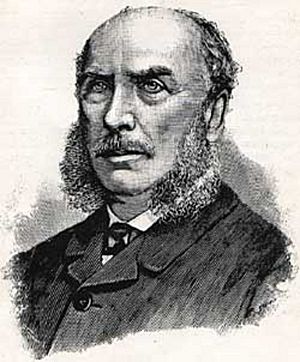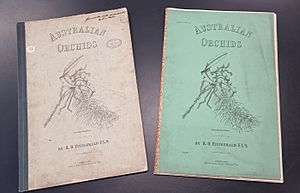Robert D. FitzGerald facts for kids
Quick facts for kids
Robert D. FitzGerald
|
|
|---|---|
 |
|
| Born | 30 November 1830 |
| Died | 12 August 1892 (aged 61) Hunters Hill, Sydney, New South Wales
|
| Occupation | surveyor, ornithologist, botanist and poet |
| Spouse(s) | Emily Blackwell |
| Children | three sons and three daughters |
| Parent(s) | Robert David FitzGerald & Mary Ann, née Bell |
Robert David FitzGerald (born November 30, 1830 – died August 12, 1892) was an amazing Irish-Australian man. He was a surveyor, someone who studies birds (an ornithologist), someone who studies plants (a botanist), and even a poet!
While working for the government, FitzGerald became incredibly skilled at studying birds and plants. He even talked directly with famous scientist Charles Darwin about Australian plants. Darwin mentioned FitzGerald several times in his 1877 book, The Different Forms of Flowers on Plants of the Same Species. FitzGerald also collected orchids for another well-known botanist, Ferdinand von Mueller.
His incredible talent led him to create a huge work over seven years called Australian Orchids. Another botanist, Joseph Dalton Hooker, said this work "would be an honour to any country and to any Botanist." This means it was a truly special achievement!
Contents
Biography: Robert FitzGerald's Life Story
Early Life and Education
Robert FitzGerald was born in Tralee, a town in County Kerry, Ireland. His father, also named Robert David FitzGerald, worked as a banker. His mother was Mary Ann Bell. Robert studied civil engineering at Queen's College, Cork, which is now called University College Cork. After finishing his studies, he moved to Australia.
Working as a Surveyor
FitzGerald arrived in Sydney, Australia, in 1856. Soon after, he got a job with the Department of Lands. He started as a draftsman, which means he drew detailed plans and maps for the government.
He worked steadily and in 1868, he was promoted. He became the head of the roads section in his department. By 1873, he was the Deputy Surveyor General. This was a very important role. In 1874, he also became the Chief Mining Surveyor. This meant he was in charge of surveying land for mining. He also managed Church and School Lands for New South Wales. Later, due to changes in government rules, his job was affected, and he had to leave his position.
His Passion for Nature: Birds and Plants
Outside of his government job, FitzGerald spent a lot of time studying nature. He became very good at studying birds. He was also skilled at taxidermy, which is the art of preparing, stuffing, and mounting the skins of animals to make them look alive. In 1855–56, he wrote articles about the birds of his hometown in Ireland for a local magazine.
FitzGerald was especially interested in plants, particularly orchids. In 1864, he traveled to Wallis Lake, north of Newcastle, to collect ferns and orchids. He wanted to grow these plants around his home in Hunters Hill.
His interest in orchids lasted his whole life. He visited Lord Howe Island in 1869, 1871, and 1876 to collect more plant samples. During one of these trips, he discovered a new plant. It was later named Dracophyllum fitzgeraldii F. Muell in his honor.
Family Life
FitzGerald married Emily Blackwell in 1860 in Balmain. Emily was the daughter of Edward Hunt, a member of the New South Wales Legislative Council. Robert and Emily had six children: three sons and three daughters. All of them were still alive when he passed away.
His grandson, also named FitzGerald, became a famous poet.
His Passing
Robert FitzGerald died on August 12, 1892, at his home in Hunters Hill. He was buried in the Presbyterian section of the old Balmain Cemetery.
Published Works: Australian Orchids
From 1875 to 1882, FitzGerald worked with Arthur James Stopps to publish his amazing work called Australian Orchids. Arthur Stopps was a lithographer, someone who creates prints from drawings, and he worked in the same government office as FitzGerald.
FitzGerald made very detailed drawings of orchids. These drawings were then turned into beautiful prints called lithographs. Artists then carefully hand-colored these prints following FitzGerald's instructions. Australian Orchids made FitzGerald famous around the world among plant scientists. As mentioned before, botanist Joseph Dalton Hooker praised it highly.
Australian Orchids described more than 200 different types of orchids. The government helped FitzGerald by paying for his costs and publishing his work. However, FitzGerald died before he could finish the entire project. Nearly 100 of his drawings that were never published are now kept at the State Library of New South Wales.
After drawing the orchids, FitzGerald did not save the actual plant samples. This makes it harder for scientists today to study the exact plants he described. Also, the book didn't follow a strict system for organizing the orchids. The pages and drawings weren't numbered, which can make it tricky to find a specific drawing.
Original Drawings and Letters
The original drawings by FitzGerald, created between 1874 and 1894, are very special. They include 196 water-color and pencil drawings of Australian orchids. These are kept in two volumes as part of the Mitchell and Dixson Libraries Manuscripts Collection at the State Library of New South Wales.
Many letters written by FitzGerald to the German-Australian botanist Ferdinand von Mueller are also preserved. These letters, from 1871 to 1892, talk about Australian plants and how to identify them. They are kept at the National Herbarium of Victoria in Melbourne.
Honours and Awards
Plants Named After Him (Eponyms)
When a plant or animal is named after someone, it's called an eponym. Several plants were named in honor of Robert FitzGerald:
- The spider orchid, Caladenia fitzgeraldii Rupp.
- The ravine orchid, Sarcochilus fitzgeraldii F. Muell..
- The giant Ericacea plant, Dracophyllum fitzgeraldii F. Muell. He discovered this plant on Lord Howe Island.
- The orchid, Eugenia fitzgeraldi F.Muell. & F.M.Bailey.
Medals and Recognition
FitzGerald received several medals for his important work:
- He won a bronze medal from the Agricultural Society of NSW in 1871 for his work on orchids.
- He received a gold medal from the Exhibition Internationale de Paris in 1878 for Australian Orchids.
- He earned a bronze medal from the Sydney International Exhibition in 1879.
- He was awarded a silver medal from the Melbourne International Exhibition in 1880.
- He received the Amsterdam Medal D'Or in 1883.
- He won a bronze medal from the Colonial and Indian Exhibition in London in 1886.
Memberships in Important Societies
FitzGerald was also recognized by joining important scientific groups:
- He was made an honorary member of the Field Naturalists' Club of Victoria.
- He was chosen as a fellow of the Linnean Society of London in 1874.
- He became a member of the Royal Society of New South Wales in 1876.
Other Honours
- Fitzgerald County, New South Wales was named in his honor.


